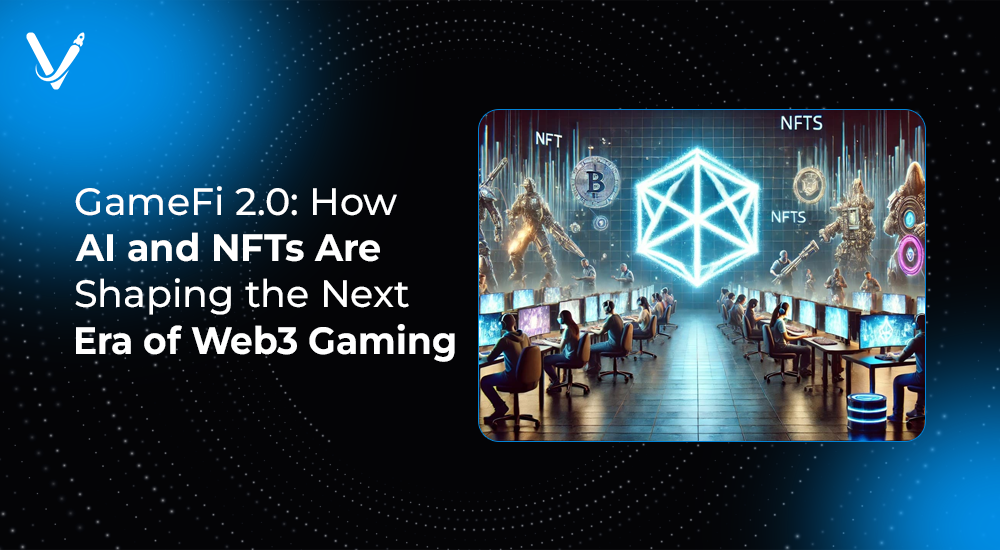GameFi 2.0: How AI and NFTs Are Shaping the Next Era of Web3 Gaming


- May 10, 2025



GameFi is rapidly evolving, fueled by technological advancements and the integration of cutting-edge innovations such as artificial intelligence (AI) and non-fungible tokens (NFTs). As Web3 gaming continues to grow, GameFi 2.0 emerges as the new paradigm, redefining player experiences and offering novel ways to earn and interact within virtual environments.
This comprehensive article delves into the transformative potential of AI and NFTs in GameFi 2.0. We will explore how these technologies are creating immersive, dynamic, and player-driven experiences, while also shaping the business models behind Web3 game development. Whether you are a game developer, an investor, or an enthusiast, this guide will equip you with valuable insights into the future of gaming.
GameFi 1.0 laid the foundation for play-to-earn (P2E) models, allowing players to earn tokens and assets through in-game activities. However, the model faced criticism for being overly speculative, leading to volatile economies and unsustainable player incentives.
Enter GameFi 2.0:
GameFi 2.0 redefines gaming as a decentralized and player-owned ecosystem. It leverages AI and NFTs to create immersive and dynamic worlds, where players can participate in sophisticated economic systems, own digital assets, and interact with intelligent game entities. Unlike its predecessor, GameFi 2.0 focuses on long-term value, sustainable tokenomics, and player-centric economies.
Core Features of GameFi 2.0:
Artificial intelligence is redefining the gaming landscape by creating more interactive, responsive, and personalized gaming experiences. In the context of GameFi 2.0, AI is leveraged to build adaptive game worlds, intelligent NPCs, and sophisticated economic systems.
1. Procedural Content Generation (PCG):
AI algorithms generate unique levels, quests, and landscapes based on player behavior and preferences. This ensures that each gaming session is different, maintaining player engagement over time.
Example:
In the game Illuvium, AI-generated terrains and ecosystems allow players to explore dynamic environments filled with rare creatures that evolve based on player interactions.
2. Intelligent NPCs and Virtual Assistants:
AI-controlled NPCs can react to player actions, learn from interactions, and simulate complex behaviors. These intelligent entities create more realistic game worlds, enhancing the sense of immersion.
Example:
Star Atlas, a space exploration game, employs AI-driven NPCs that act as merchants, bounty hunters, or allies, each with distinct personalities and decision-making capabilities.
3. Player Behavior Analysis:
AI analyzes player data to optimize game difficulty, suggest personalized quests, and predict market trends within in-game economies.
Example:
The Sandbox uses AI analytics to monitor player behavior, enabling developers to tweak game mechanics and introduce targeted quests that align with player interests.
Non-fungible tokens (NFTs) serve as the foundational layer for digital asset ownership in Web3 gaming. Unlike traditional in-game assets, NFTs provide verifiable ownership, scarcity, and interoperability across multiple platforms.
How NFTs Are Transforming GameFi 2.0:
Case Study:
Axie Infinity revolutionized P2E gaming by enabling players to breed, battle, and trade Axie NFTs. Each Axie is a unique asset, and rare Axies command significant market value. Players can also stake their NFTs, earning passive income in the form of AXS tokens.
Building a successful GameFi 2.0 project requires a comprehensive understanding of blockchain integration, AI deployment, and NFT economics. Here are key strategies:
1. Design Sustainable Economies:
Implement tokenomics that balance rewards, supply, and demand. Introduce deflationary mechanisms to prevent token inflation.
2. Integrate AI for Dynamic Interactions:
Develop AI-powered NPCs that respond to player actions, creating more engaging and unpredictable gameplay.
3. Build NFT Marketplaces:
Facilitate asset trading by creating in-game NFT marketplaces where players can buy, sell, or trade assets without leaving the game.
4. Implement Cross-Chain Interoperability:
Enable NFTs to function across different blockchain networks, enhancing asset liquidity and increasing player retention.
1. The Sandbox:
A metaverse game where players buy and develop land plots represented as NFTs. AI-driven NPCs act as guides, merchants, and quest-givers, creating a dynamic game world.
2. Star Atlas:
Players explore a vast universe, engage in space battles, and earn resources through NFT-backed spaceships. AI algorithms adjust space missions based on player behavior, ensuring varied gameplay.
3. Decentraland:
A decentralized virtual world where users can buy, build, and monetize land parcels. AI-powered avatars provide personalized quests and interactive experiences.
As AI and NFTs continue to mature, GameFi 2.0 will evolve in the following ways:
GameFi 2.0 is more than a trend — it is a paradigm shift that redefines gaming through AI, NFTs, and decentralized finance. By integrating these technologies, developers can create dynamic, player-owned ecosystems where assets hold real-world value and gameplay evolves in response to player actions. Vasundhara Infotech is at the forefront of this revolution, offering cutting-edge Web3 game development services that harness AI and NFTs to build engaging, profitable gaming experiences.
Ready to transform your game into a Web3 success? Contact us today and explore how AI and NFTs can elevate your project to the next level.
Copyright © 2025 Vasundhara Infotech. All Rights Reserved.